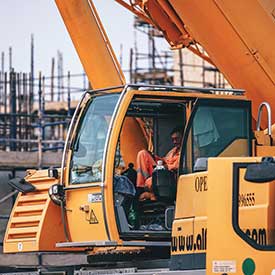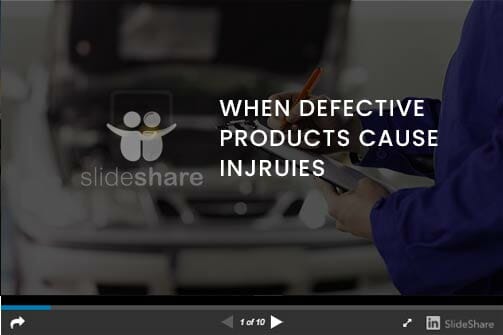For many people, the first image that comes to mind in response to the words “industrial equipment” is a factory assembly line full of whirring machines and conveyor belts. Factories are certainly one setting where people work closely with industrial equipment, but industrial equipment takes many other forms as well, from tractors to box crushers to ice cream machines. Every day, countless American workers come in contact with industrial equipment in the course of performing a wide variety of jobs.
 Machines are supposed to make work easier and more efficient, and there’s certainly a lot that we couldn’t do without them, but working with or near them can also be one of the most dangerous parts of a workday, especially when proper safety equipment, training, and policies aren’t provided or observed.
Machines are supposed to make work easier and more efficient, and there’s certainly a lot that we couldn’t do without them, but working with or near them can also be one of the most dangerous parts of a workday, especially when proper safety equipment, training, and policies aren’t provided or observed.
As recorded by the Bureau of Labor Statistics (BLS), 5,147 people died of work-related causes in the U.S in 2017. Contact with equipment accounted for 695 of those fatalities, making it the fourth most common cause of occupational death after vehicular accidents, falls, and violence. A further 136,510 workers were also injured by contact with equipment in 2017, severely enough to require days away from work.
Of the cases OSHA inspected in 2017, nearly two-thirds of all workplace fatalities were the result of safety code violations. Workplace accidents often go unreported, so it’s entirely possible the true numbers are even higher, but what’s clear is that a lack of regard for worker safety causes thousands of tragedies per year, many of them sustained while operating hazardous equipment.
Worker Safety Has Improved, but Progress Is Slow and Spotty
American working conditions have come a long way since the days of children in coal mines, but there’s a long way left to go before safe workplaces can be considered the norm, and the post-recession economy has allowed for a recent stagnation in safety advancements.
A study of machine-related occupational fatalities from 1992 through 2010 found that these kinds of deaths were dropping by about 2.8% per year during that time. While that may sound promising, it still means that an average of 770 people died in industrial equipment accidents during each of those 18 years, and seven years later, the trend of improvement has not held. The death rate from industrial equipment accidents in 2017 was only 6% lower than in 2010 — a far cry from the roughly projected 18% drop-off. Worse still, even that small improvement appears to be little more than random year-to-year chance, when you consider that 2016’s industrial equipment death rate was 3% higher than 2010’s.
Georgia in particular has seen a sharp rise in occupational fatalities across the board since 2010. As the job market slowly recovers, employers are able to send waves of new hires to work in unfamiliar positions with inadequate training, knowing that the fear of returning to unemployment will keep most of them from complaining about hazardous conditions.
It may take years or decades to recover even the moderate momentum toward safety that existed in 2010, but overarching trends do nothing to excuse the actions of the individual employers who choose to put workers at risk out of greed or laziness. Now and always, everyone deserves a workplace free of needless dangers, and that’s what employers are responsible for providing.
How Do Industrial Equipment Accidents Happen?
The Atlanta Business Chronicle recently compiled the OSHA reports on 25 worker deaths in Georgia alone, between the years 2017 and 2018. Of them, eight deaths were the result of industrial equipment accidents — equal to the number of vehicular accidents and higher than any other cause.
In one case, a street sweeper operator was trapped and crushed between the hopper and hydraulic arm of his sweeper. Other incidents included workers being struck on the head by a barrel hoist, struck by a floor roller, and crushed by an aerial lift. More than one of the employers involved had already been cited for relevant safety violations, and in the case of the floor roller incident, another employee had also died in an industrial accident at the same facility just seven months earlier.
Similar patterns emerge among nonfatal incidents as well. Also in Georgia in 2018, an employee of a wooden post manufacturer suffered a partial hand amputation while working on equipment that had no guards or emergency shutoff features, in spite of years of OSHA citations for repeat violations.
Because there are so many different kinds of industrial equipment, there’s no standard accident scenario, but there are some common elements that many incidents share:
- Safety guards that have been removed to increase the pace of work
- Lack of available safety gear
- Inadequate or infrequent safety training
- Supervisors directing workers to perform tasks they are not qualified for
- Workers attempting to service equipment that is running
In one study conducted by the BLS, examining industrial equipment injuries that occurred during cleaning, unjamming, and other non-operating activities, the machines had been left running in 78% of cases. In another 10%, they had been turned off but were then accidentally turned back on while the task was in progress. Common reasons given for leaving the power on included not thinking it was necessary to turn it off and not wanting to slow down production. Both are issues that could have been solved through better training and a workplace culture that prioritizes safety over meeting quotas.
Who Is Most Affected by Industrial Equipment Accidents?
On average, workers in agricultural, construction, manufacturing, and service-based positions have the highest risk of being injured or killed by industrial equipment, and older adults have a significantly elevated risk. This may be due to declining coordination, decreased use of safety gear due to overconfidence, and/or older self-employed adults (such as farm owners) using older, less safe equipment.
There are particular risks for teenage workers as well. According to a survey by the Centers for Disease Control (CDC), an average of 47 underage workers die every year in the U.S of work-related causes, 20% of them due to contact with objects or machinery. The number sounds small, but these are deaths that occur in spite of the fact that workers under 18 are not legally allowed to use most industrial equipment at all, or work in positions that are recognized as hazardous.
Teens are more likely to underestimate risk than adult workers are, and their different bodily proportions can sometimes make it impossible for them to use machinery and safety gear correctly, yet they are often illegally required to operate industrial equipment anyway. One nationwide survey of teens in service positions in 2006 found that nearly 37% had been ordered to operate heavy equipment or perform other illegally hazardous duties. A survey of teenage construction workers in South Carolina during the summer of 2001 found the percentage to be as high as 84%. Teens are also commonly employed “off the books,” making it even more difficult to keep thorough records of their workplace injuries than it is for adults.
How to Protect Yourself While Working with Industrial Equipment
Much of your safety will depend on how safe your workplace is and what your employer requires you to do, but there are some things you can do to improve your own odds. If your job comes with safety training, learn and follow those rules first and foremost. They’re likely to be more relevant to the situations you’ll encounter than all-purpose guidelines will be. That said, there are some general sources of safety advice that many users of industrial equipment will find useful, such as OSHA, Business and Legal Resources, and Convergence Training. Familiarize yourself with the essentials, such as:
- Never attempting to defeat safety features
- Reporting all potential equipment problems to your supervisor immediately
- Never leaving equipment unattended with parts running
- Removing safeguards only when absolutely necessary for service, and only when the machine has been shut down and locked out
- Securing long hair, removing jewelry, and wearing close-fitting clothes during work
- Observing all capacity, operation, and maintenance warnings
- Using equipment only for work, and only for the purpose for which it was intended
If you are instructed to disregard these or any other safety precautions, or if your workplace’s industrial machines are not equipped with the safety guards required by OSHA, carefully consider filing a complaint. Under the law, your employer may not take any adverse action against you for reporting unsafe conditions. However, many workers understandably do not want to test an already lawbreaking employer’s respect for whistleblower protections. If you choose not to report a hazard to OSHA, your choice does not change anything about your employer’s negligence or your right to compensation if an accident does occur.
The Stoddard Firm Has Experience Advocating for Industrial Accident Victims
Theoretically, workers’ rights should be protected automatically by OSHA, but the theory and the reality are very far apart in this regard. OSHA performs tens of thousands of inspections annually, issuing citations and sometimes imposing fines, but according to an investigation by the New York Times, it almost never exercises its power to refer a case for actual prosecution.
OSHA’s recordkeeping policies can even make prosecution more difficult. The Times’ investigation uncovered a consistent pattern of companies successfully pressuring OSHA into downgrading citations of willful negligence to “unclassified” negligence, in return for promises of improvement. Not only is this an inaccurate and insufficient response to even one instance of willfully endangering workers, but this option has been granted to companies even after repeated violations of the same regulations, and even after these violations have led to multiple deaths.
Representatives of OSHA interviewed during the investigation cited a lack of interest by federal prosecutors as one of the main reasons for OSHA’s own lack of legal action. Absurdly, killing a worker through willful negligence is only a misdemeanor, subject to a maximum six month prison sentence and a median fine of just over $30,000, none of which benefits the victim’s family. Under federal law, it’s cheaper for many companies to continue endangering workers under the assumption that they’ll never face serious consequences than to invest in safer equipment and training, or to allow employees to work more slowly when safety requires it.
Thankfully, civil law offers more options for justice where criminal law falls short, and the Stoddard Firm is dedicated to offering the best possible legal support to industrial accident victims and their families. Even if your accident resulted from a lapse of concentration on your part, we understand that nobody can be 100% alert every moment, especially while working exhaustingly long hours. Workplaces and policies need to be designed with this reality in mind. We’ll take the time to go over your individual case in detail, from the circumstances that allowed the accident to occur, to how your future will be affected. We’ll make sure you get the settlement you deserve, both to provide you with the resources you need to recover, and to send a message to businesses that disregard for human life and wellbeing is not cheap.
If you or a loved one have been injured or killed in an industrial equipment accident due to a defect or other reasons, give us a call right away at 678-RESULT, or reach out through our online chat function. Our Atlanta legal experts are standing by to provide you with a free consultation on your case and how we can help.
Attorney Matt Stoddard
 Matt Stoddard is a professional, hardworking, ethical advocate. He routinely faces some of the nation’s largest companies and some of the world’s largest insurers – opponents who have virtually unlimited resources. In these circumstances, Mr. Stoddard is comfortable. Mr. Stoddard provides his strongest efforts to his clients, and he devotes the firm’s significant financial resources to presenting the strongest case possible on their behalf. Matt understands that his clients must put their trust in him. That trust creates an obligation for Matt to work tirelessly on their behalf, and Matt Stoddard does not take that obligation lightly. [ Attorney Bio ]
Matt Stoddard is a professional, hardworking, ethical advocate. He routinely faces some of the nation’s largest companies and some of the world’s largest insurers – opponents who have virtually unlimited resources. In these circumstances, Mr. Stoddard is comfortable. Mr. Stoddard provides his strongest efforts to his clients, and he devotes the firm’s significant financial resources to presenting the strongest case possible on their behalf. Matt understands that his clients must put their trust in him. That trust creates an obligation for Matt to work tirelessly on their behalf, and Matt Stoddard does not take that obligation lightly. [ Attorney Bio ]


 Machines are supposed to make work easier and more efficient, and there’s certainly a lot that we couldn’t do without them, but working with or near them can also be one of the most dangerous parts of a workday, especially when proper safety equipment, training, and policies aren’t provided or observed.
Machines are supposed to make work easier and more efficient, and there’s certainly a lot that we couldn’t do without them, but working with or near them can also be one of the most dangerous parts of a workday, especially when proper safety equipment, training, and policies aren’t provided or observed. Matt Stoddard is a professional, hardworking, ethical advocate. He routinely faces some of the nation’s largest companies and some of the world’s largest insurers – opponents who have virtually unlimited resources. In these circumstances, Mr. Stoddard is comfortable. Mr. Stoddard provides his strongest efforts to his clients, and he devotes the firm’s significant financial resources to presenting the strongest case possible on their behalf. Matt understands that his clients must put their trust in him. That trust creates an obligation for Matt to work tirelessly on their behalf, and Matt Stoddard does not take that obligation lightly. [
Matt Stoddard is a professional, hardworking, ethical advocate. He routinely faces some of the nation’s largest companies and some of the world’s largest insurers – opponents who have virtually unlimited resources. In these circumstances, Mr. Stoddard is comfortable. Mr. Stoddard provides his strongest efforts to his clients, and he devotes the firm’s significant financial resources to presenting the strongest case possible on their behalf. Matt understands that his clients must put their trust in him. That trust creates an obligation for Matt to work tirelessly on their behalf, and Matt Stoddard does not take that obligation lightly. [ 



